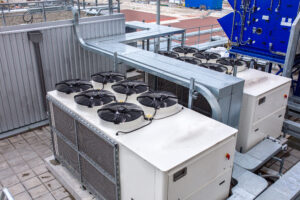
Heat Pumps and the International Codes: Uncovering Pathways to Reduce Greenhouse Gas Emissions
With heat pumps being the most economical and the most suitable alternative to gas-fired heating systems, their recognition in the I-Codes will be paramount to meeting all current and future GHG reduction goals.
The construction and operation of buildings account for roughly 40 percent of global greenhouse gases (GHGs), with the emissions from building operations being nearly 30 percent.
A major source of these GHGs comes from the burning of fossil fuels to heat buildings and homes (primarily natural gas and propane), making it one of the primary targets for communities, cities and states looking to reduce their carbon footprint.
Reducing the Carbon Footprint Through Heating Systems
There are multiple solutions for reducing carbon emissions generated by heating systems in the built environment. These can range anywhere from increasing the energy efficiency requirements of gas and electric heating appliances, to transitioning to renewable energy resources, such as wind and solar power.
Since the enactment of the Energy Policy and Conservation Act of 1975, and the subsequent formation of the U.S. Department of Energy (DOE), energy efficiency requirements have improved significantly.
DOE continues to review existing product standards, analyze markets and set new energy efficiency requirements for residential and commercial appliances and equipment, and there is no indication this process will change. For some communities, continued compliance with the DOE’s efficiency requirements for both gas-fired and electric appliances and equipment may be enough to satisfy local requirements for reducing GHGs. For others, greater measures may be necessary.
In areas where electrification is underway, or being considered, a complete transition from fossil fuels to electricity comes with many challenges. The financial hurdles associated with strengthening the electric grid and changing out gas-fired heating appliances and equipment for electric equivalents are just a few of the challenges that must be faced. In these areas, a well-rounded approach should not only focus on electrification but should also focus on energy efficiency and renewable energy sources.
Regardless of the path chosen to reduce the carbon footprint, there are technologies available, and new innovative products in the pipeline, to help communities meet their carbon reduction goals.
Additionally, in areas where the International Codes® (I-Codes) are adopted, building codes will not hinder meeting these goals. The I-Codes currently reference the DOE’s minimum efficiency for fossil fuel and electric equipment and are in sync with the DOE requirements.
So, in areas relying solely on the DOE efficiency requirements for reducing GHGs, the process is easy. In areas moving away from fossil fuels, it is a little more complicated.
Turning to Electrification to Reduce GHG Emissions
Communities choosing the path of electrification to reduce GHGs must consider how buildings and homes are currently heated in their area.
Historically in the U.S., the split between gas-fired heating and electric heating has been pretty much down the middle 50/50. However, based on geography, available fuel sources and other variables, some areas favor gas-fired heating appliances and others favor electric heating appliances.
Consideration must be given to the number of buildings and homes with gas-fired heating systems when determining how and when the electrification transition takes place. Likewise, consideration must be given to the types of electric heating appliances that can be used to replace gas-fired appliances.
The most common methods of heating a home or building using electricity are with electric heat pumps, furnaces, space heaters and boilers – all of which are types of electric heating equipment recognized by the I-Codes for use in residential and commercial construction.
Of these, arguably the most economical for whole home/building heating is the heat pump, and of the various equipment types, it is the only one capable of heating a space during cold months and cooling a space during hot months.
For this reason, heat pumps are the most suitable alternative to gas-fired heating systems including central heating and air-conditioning systems.

Heat Pumps
Air source heat pumps are common in the U.S. and have been used for decades throughout the south. However, since they rely on absorbing heat from outdoor air and transferring it inside, historically they have not performed well in the north.
Fortunately, new innovations in air source heat pump design enable many current products to operate efficiently at temperatures below zero degrees Fahrenheit. These include:
- New cold-weather refrigerants
- Multi-stage compressor designs to improve seasonal efficiencies
- Variable speed fans to deliver air at comfortable temperatures
- Improved coil designs to transfer heat more efficiently
In addition to air-source heat pumps, ground-source heat pumps are becoming more commonly available.
These systems, unlike air source heat pumps, transfer heat to and from the ground, lakes or wells instead of the outside air. Because these mediums are more stable in temperature year-round, ground-source heat pumps are more efficient than air source heat pumps. However, where air-source heat pumps are similar in cost to cooling-only equipment, ground-source heat pump systems require the installation of long lengths of buried or submerged heat transfer loop piping that can significantly increase upfront construction costs.
In addition to these common heat pump products, in the commercial market, industrial heat pumps (IHPs) are beginning to find their way into the U.S.
IHPs, which are heat pumps that capture waste heat from industrial processes and apply it to the building space heating load, have been used overseas for years and have proven to be reliable sources for comfort heating in various commercial applications.
These electric-powered heat pumps, as well as gas engine-type heat pumps, are recognized in the latest 2021 version of the I-Codes.
The Code Council’s 2021 International Codes
The 2021 International Residential Code® (IRC) covers all code requirements for residential construction. The IRC includes mechanical, plumbing, fuel gas, energy efficiency and electrical provisions specifically addressing all types of heat pump equipment for residential use and references all current industry standards for the various types of heap pump equipment.
Where many of the provisions for heat pump equipment share commonality with air conditioning-only equipment, the IRC includes heat pump-specific sections covering:
- Electric heat pump systems
- Ground-source heat pump system loop piping
- Heat pump pool heaters
- Gas-fired heat pump systems
The International Mechanical Code® (IMC), International Fuel Gas Code® (IFGC), International Energy Conservation Code® (IECC) and International Swimming Pool and Spa Code® (ISPSC) cover code requirements for commercial construction.
These I-Codes, combined, include all required code provisions specifically addressing all types of heat pump equipment for commercial use, and like the IRC, include references to all current industry standards for heat pump equipment.
The IMC includes heat pump-specific sections covering:
- Electric heat pump systems
- Electric heat pump refrigeration systems
- Ground-source heat pump system loop piping
- Gas-fired heat pump systems
The IFGC includes heat pump-specific sections covering:
- Gas-fired absorption heat pump systems
- Gas-fired heat pump systems
The IECC includes heat pump-specific sections covering:
- Heat pump systems
- Hydronic (water loop) heat pump systems
- Heat pump water heaters
- Heat pump pool heaters
The ISPSC includes heat pump-specific sections covering:
- Heat pump pool heaters
The heat pump code provisions found across the family of I-Codes address all currently available heat pump technologies, including the new and innovative IHPs that are coming to our shores.
SEE RELATED: The International Code Council’s Plumbing and Mechanical Codes Are Paving the Way for More Resilient Communities
Using Heat Pumps to Lower GHG Emissions
With heat pumps being the most economical and the most suitable alternative to gas-fired heating systems, their recognition in the I-Codes will be paramount to meeting all current and future GHG reduction goals.
Visit the Code Council’s PMG webpage to learn more.
Learn more about the Code Council’s I-Codes, here.







